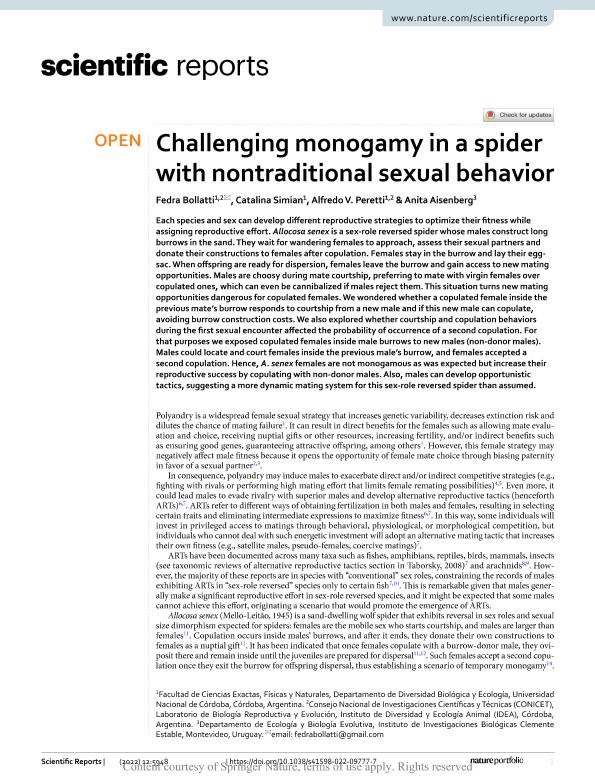Artículo
Challenging monogamy in a spider with nontraditional sexual behavior
Bollatti, Fedra Ariana ; Simian, Catalina
; Simian, Catalina ; Peretti, Alfredo Vicente
; Peretti, Alfredo Vicente ; Aisenberg Olivera, Anita Diana
; Aisenberg Olivera, Anita Diana
 ; Simian, Catalina
; Simian, Catalina ; Peretti, Alfredo Vicente
; Peretti, Alfredo Vicente ; Aisenberg Olivera, Anita Diana
; Aisenberg Olivera, Anita Diana
Fecha de publicación:
08/04/2022
Editorial:
Nature Publishing Group
Revista:
Scientific Reports
ISSN:
2045-2322
Idioma:
Inglés
Tipo de recurso:
Artículo publicado
Clasificación temática:
Resumen
Each species and sex can develop different reproductive strategies to optimize their fitness while assigning reproductive effort. Allocosasenex is a sex-role reversed spider whose males construct long burrows in the sand. They wait for wandering females to approach, assess their sexual partners and donate their constructions to females after copulation. Females stay in the burrow and lay their egg-sac. When offspring are ready for dispersion, females leave the burrow and gain access to new mating opportunities. Males are choosy during mate courtship, preferring to mate with virgin females over copulated ones, which can even be cannibalized if males reject them. This situation turns new mating opportunities dangerous for copulated females. We wondered whether a copulated female inside the previous mate's burrow responds to courtship from a new male and if this new male can copulate, avoiding burrow construction costs. We also explored whether courtship and copulation behaviors during the first sexual encounter affected the probability of occurrence of a second copulation. For that purposes we exposed copulated females inside male burrows to new males (non-donor males). Males could locate and court females inside the previous male's burrow, and females accepted a second copulation. Hence, A.senex females are not monogamous as was expected but increase their reproductive success by copulating with non-donor males. Also, males can develop opportunistic tactics, suggesting a more dynamic mating system for this sex-role reversed spider than assumed.
Archivos asociados
Licencia
Identificadores
Colecciones
Articulos(IDEA)
Articulos de INSTITUTO DE DIVERSIDAD Y ECOLOGIA ANIMAL
Articulos de INSTITUTO DE DIVERSIDAD Y ECOLOGIA ANIMAL
Citación
Bollatti, Fedra Ariana; Simian, Catalina; Peretti, Alfredo Vicente; Aisenberg Olivera, Anita Diana; Challenging monogamy in a spider with nontraditional sexual behavior; Nature Publishing Group; Scientific Reports; 12; 1; 8-4-2022; 1-10
Compartir
Altmétricas



